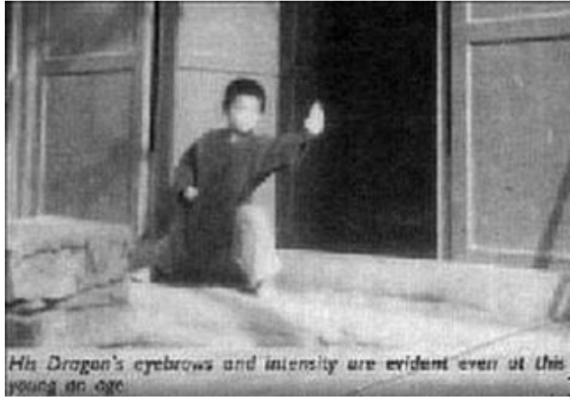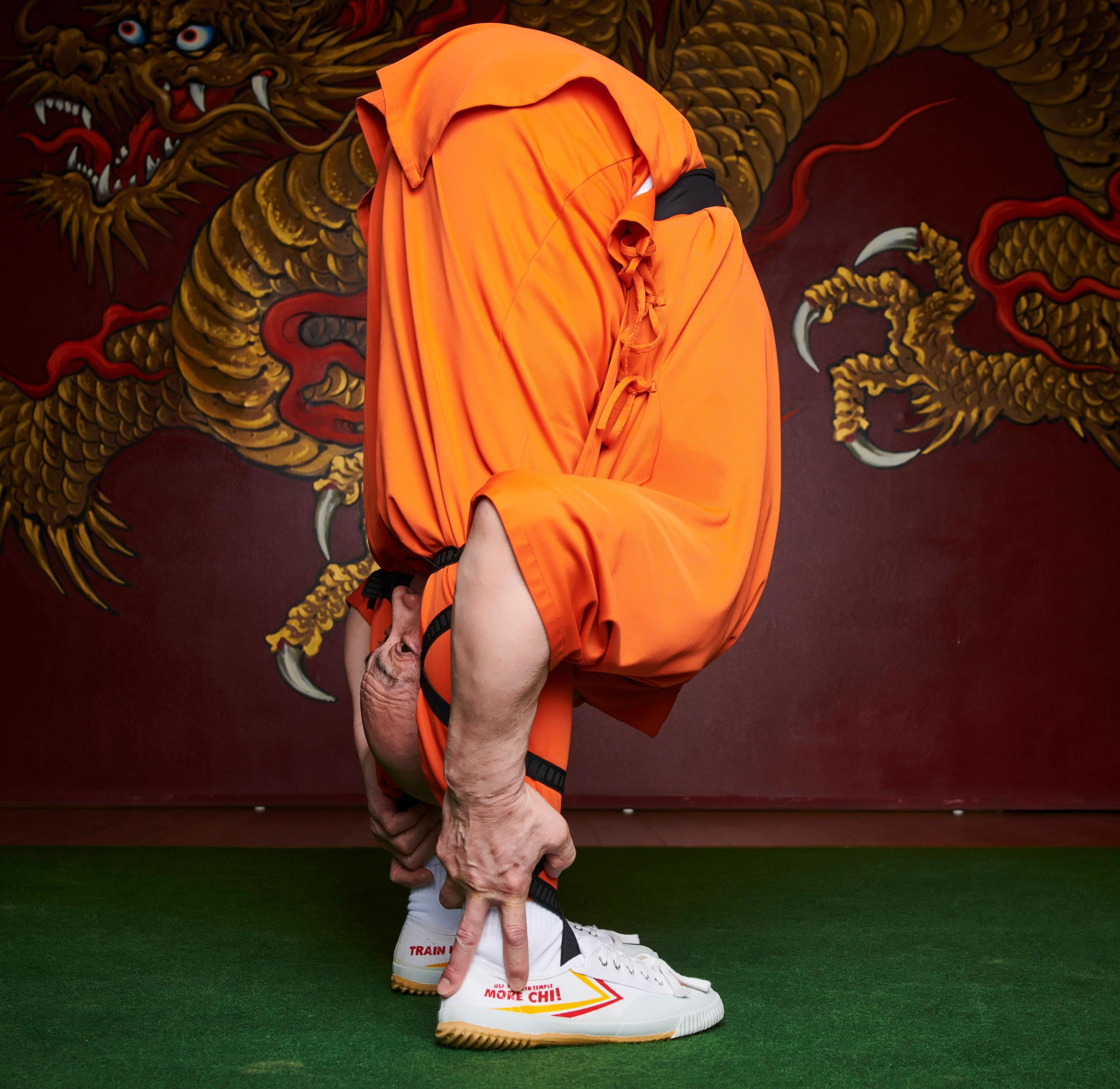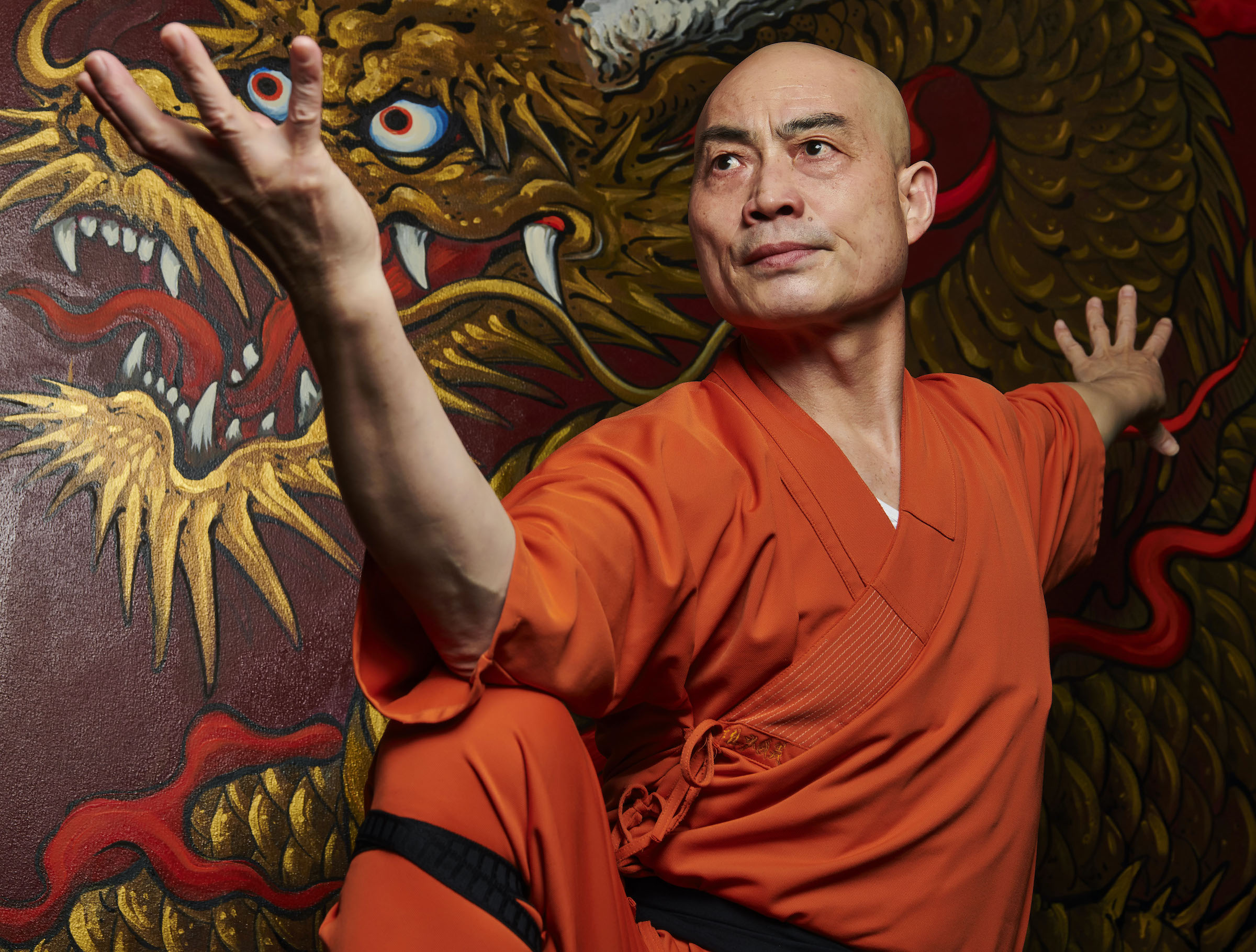Shi Yan Ming didn’t intend to make me feel bad. But when a 40-something journalist asks a 59-year-old interviewee to confirm his age, it’s not really appropriate to lift a straight-kneed leg over your head in response. Frankly, it’s a little upsetting.
Not that Shi’s age-defying dexterity should be surprising. He is a living legend in the world of martial arts, a 34th generation warrior monk from China’s legendary Shaolin temple who can break bricks with his bare hands, execute upside down flying kicks, and bend razor-sharp spears with his neck. And on the brink of his sixth decade in this earthly realm, Shi still takes pleasure in passing on the secrets of kung fu and Chan (Zen) Buddhism to both movie stars and harassed office workers.
“I have private students, classes, and train myself every day,” Shi tells TIME via a Zoom call from the USA Shaolin Temple, which he established in New York City in 1994. The relentless quest, he says, is to “sharpen my life.”
It’s a life that has transported Shi from abject poverty in rural China to performing kung fu on behalf of its communist government, defection to the U.S., and then training some of Hollywood’s biggest names, like Wesley Snipes, Bokeem Woodbine, and WuTang Clan’s RZA—who dubbed Shi a “real life superhero.”

After honing his fighting skills since the age of five, Shi is famed for extraordinary feats of physical and mental prowess, including his fabled “one-inch punch,” which is more powerful than a car traveling at 35 mph, according to The History Channel series “Stan Lee’s Super Humans.” He has also taught at the U.S. Naval Academy and spoken at Harvard and the U.N.
But no challenge Shi had previously faced quite matched up to COVID-19, which shuttered his school in the Lower East Side for two years and seven months, only to reopen late last year. Shi experienced pandemic-inspired anti-Asian hate firsthand and believes, with the WHO recently stating COVID-19 is no longer a global health emergency, that people everywhere can use the hardship as a springboard to find inner peace and satisfaction.
“In the pandemic, many people got disconnected from reality, and spiritually [suffered] a lot,“ says Shi. “Life is so short, life is precious, we have to cherish every moment— every day, it’s a beautiful gift.“
Shi was born the seventh of nine children in a desperately poor family in China’s central province of Henan. Per local custom at the time, Shi’s mother had her feet bound, while his father went door-to-door performing odd jobs for food. Three elder siblings starved to death in Mao Zedong’s disastrous “Great Leap Forward” industrial experiment of the late 1950s.
Shi fell extremely ill as a toddler, forcing his father to sell the family’s few prized possessions to pay for doctors. After Shi grew cold and unresponsive, his parents thought he had died and were preparing to dispose of his body when a passing medicine man noticed their distraught weeping and asked to see the child. He performed acupuncture on Shi, who quickly roused. Partly in thanks for the supposed divine intervention, and partly to ward off future malaise, Shi’s parents, both devout Buddhists, decided to take him to the Shaolin Temple to recuperate. “My parents had no idea what was wrong with me, but they believed Buddha could save my life,“ says Shi.
The Shaolin temple was founded in A.D. 495 on the forested slopes of China’s sacred Mount Songshan in what is today Henan province’s Dengfeng county. According to legend, the monastery’s fighting tradition evolved from a group of monks who were martial artists before taking orders, and taught their fellow brothers via perfecting household chores like sweeping, collecting firewood, and fetching buckets of river water. Before long, rival warlords would entreat the warrior monks to help in their skirmishes.
Such a focus on martial prowess may seem at odds with a religion as dedicated to non-violence as Buddhism. However, early Buddhist iconography often flanks the Buddha with heavily-armed, ferocious-looking deities who trample demons underfoot. As scholar Meir Shahar notes in his definitive book, The Shaolin Monastery, “if the world-honored one required the protection of martial gods, then his monastic community certainly needs the defense of martial monks.”
At the age of 5, Shi was accepted by Shaolin’s chief monk, but life in the temple was far from tranquil. Mao’s frenzied Cultural Revolution was in full swing, during which all ancient religion and culture was purged. The temple’s walls had already been destroyed during a bout of inter-clan fighting in 1926, though Mao’s fearsome Red Guards picked up where the warlords left off, smashing all buildings, statues, and relics. Monks were forbidden from even wearing their robes. “It was hard to live there,“ Shi says.
As time went on, Shi began to be trained in the ways of Chan (Zen) Buddhism and Shaolin kung fu. Rising at 4:30 a.m., he spent each day engrossed in meditation, chores, and training. Monks slept on a piece of wood with a blanket and bundled their clothes for a pillow. The temple had no electricity until 1981 and no running water until 1986. By the age of 17, Shi could dangle a 40-pound weight from his testicles and sleep standing on one leg.
“A master would order me to do a handstand and then just walk away,“ recalls Shi. “I felt like my eyeballs would almost pop out, arms swelling, body sore,“ he says. “Chinese culture is different from Western culture. Physically, they just push you very hard.”
It was a grueling regimen that these days would be considered abuse, and China’s kung fu schools continue to be hit by accusations of mistreatment. However, Shi remains grateful for the opportunities his unconventional upbringing brought. “My generation and today’s generation are totally different,“ he says. “I appreciate they were empowering young men— physically, mentally, spiritually—to stand tall. And now I can share my knowledge, wisdom, spirit, and physical experience with the rest of the world.”
Despite decades of official repression, the Shaolin Temple enjoyed an unexpected renaissance following the eponymous 1982 film starring a young Jet Li. The movie was a sensation, selling half a billion tickets at the Chinese box office, and propelling Shaolin kung fu into Western popular culture. Shi was living at the temple when Li arrived to film, though was unconvinced by the actor’s true potency. “His performance is of a high level, he is an awesome martial artist,“ says Shi. “But a real fight, in combat, is a totally different story.”
Still, the buzz surrounding the film meant the Shaolin temple began receiving floods of tourists and wannabe warriors. The Chinese government, meanwhile, mirrored its newfound flexibility embracing capitalism by also leveraging Shaolin kung fu’s cultural caché. The crumbled buildings were resurrected and before long, training academies peppered the surrounding hillside.
Shi was selected for the temple’s first overseas tour of the U.S. in 1992. But following the final performance in San Francisco, Shi decided to defect. He snuck outside and jumped in a cab but, unable to speak English, could only gesture for the driver to keep moving. After a while, the driver took Shi to a Chinese restaurant in Oakland which was just closing up.
“But they only spoke Cantonese, not Mandarin!“ recalls Shi with a shake of his head. “So I used the pad to write down ‘I need your help.’ And then they said, ’okay’ and made me a plate of fried noodles.
Shi called a friend of a friend who lived in San Francisco. He picked him up and let him stay in his basement for a week. Shi’s defection caused huge waves; the Chairman of China’s Martial Arts Association and the Mayor of Dengfeng were leading the tour, which was one of the first bilateral engagements following the diplomatic freeze sparked by the Tiananmen Square massacre three years earlier.
Shi, however, has no regrets: “My life’s purpose is to help as many people as possible.”
Shi’s life has changed radically in the three decades since his defection. Fully settled in New York City, and today a proud U.S. citizen, he remains unmarried but has two kids, a boy and a girl. In a departure from Buddhist clerical orthodoxy, he occasionally eats meat and enjoys the occasional drink too.
The Shaolin Temple, meanwhile, has also transformed. Today, it is more of a martial arts theme park than a pious sanctuary. When TIME last visited the monastery in 2018, novice monks did daily performances for crowds of tourists snacking on sunflower seeds and instant noodles. The gift shop overflowed with instructional DVDs, posters, and calendars.
Shi chooses his words carefully when asked to comment on the commercialization of his former home, which he has not visited since 2008. “To be a real Shaolin monk, it is not enough to practice martial arts,“ he says. “It’s the philosophy of Chan Buddhism. First, you must shave your head, eat Buddhist food, dress in robes, understand how to challenge yourself, how to discipline yourself.

But in recent years, kung fu has fallen down the martial arts pecking order, with the rise of Mixed Martial Arts, or MMA. The florid acrobatics of kung fu may look spectacular on screen but barely feature in serious competition, perhaps propelling the rise to a growing cadre of kung fu practitioners who claim supernatural skills, such as superhuman strength and telekinesis.
It’s a trend that Shi has been vocal at combatting, insisting the true essence of Shaolin lies not in cheap conjuring tricks, but the underpinning spirituality. He backs the publicity campaign of Beijing MMA fighter Xu Xiaodong, who grew to global notoriety in 2018 when he defeated a Tai Chi master who claimed supernatural powers in 20 seconds.
Shi says Xu “did a fantastic job. I respect him, I love him, more people should stop these liars. They disrespect Chinese martial arts, disrespect Chinese culture, disrespect themselves.“ Rather than feel threatened by MMA, Shi says he loves watching UFC bouts, especially those of Jon “Bones“ Jones, Demetrious Johnson, and Urijah Faber. “I like the fast guys a lot,“ he says.
Regarding the spiraling acrimony between his ancestral and current home, which has been dubbed a “new Cold War,” Shi remains diplomatic when asked about assigning blame, urging both sides to seize on common ground to repair relations. “Every country has a different way to make themselves strong, to deal with situations,“ he says. “This topic I shall leave them to figure out.”
He’s more forthright regarding the need to combat anti-Asian hate spurred by the pandemic. Twice during lockdown he found himself the subject of snide remarks on the street by people who thought he might be infected with COVID-19, which was fueled by then President Donald Trump’s use of terms like “China Virus“ and “kung flu.“
“People are not educated, they don’t love themselves, don’t rate themselves,“ says Shi. “It’s easy to blame other people, so we need to stand tall, speak out. Why hate people? Instead, loving people uses the same energy, same time. Why not turn around and love people, encourage people, and help people.“
And he believes that it’s incumbent on America’s Asian community to stand united and strong. “The Asian community should put our hands together,“ he says, “One chopstick is easy to break; ten chopsticks are much harder.”
More Must-Reads From TIME
- The 100 Most Influential People of 2024
- The Revolution of Yulia Navalnaya
- 6 Compliments That Land Every Time
- What's the Deal With the Bitcoin Halving?
- If You're Dating Right Now , You're Brave: Column
- The AI That Could Heal a Divided Internet
- Fallout Is a Brilliant Model for the Future of Video Game Adaptations
- Want Weekly Recs on What to Watch, Read, and More? Sign Up for Worth Your Time
Write to Charlie Campbell at charlie.campbell@time.com
